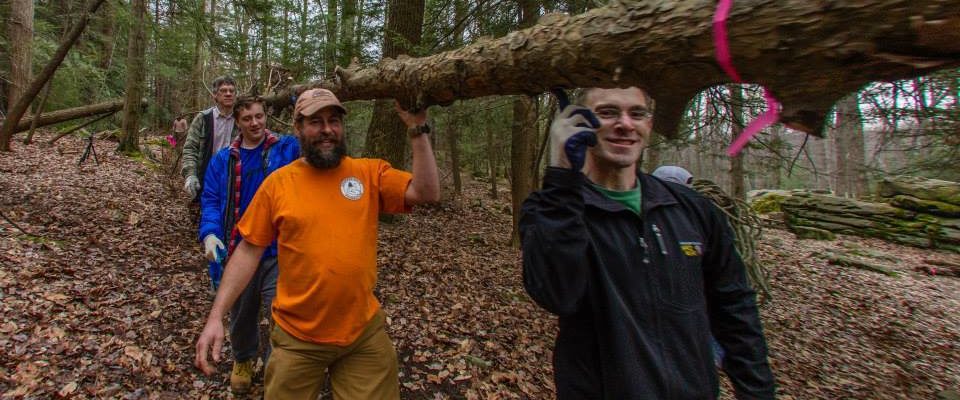–by Adam Polinski
On Sunday, August 13th, 2017, two shifts of incoming WVU Freshmen, totaling 35 brand new college students, pitched in on CRF’s ongoing efforts to upgrade Scott Run Trail.
The work they assisted with was hauling crusher run gravel in 5-gallon buckets to add a top-coating to an extremely bumpy, rough, rocky section of trail. Crusher run gravel compacts down tightly and molds easily, making it the most recreationally-friendly gravel there is. Drainage improvements are the other component of the Scott Run Trail upgrade but were not part of the day’s focus. Both the morning and the afternoon crews formed bucket brigades to move this trailbed top-coating material, and the bucket line stretched 750’ away from the gravel piles in the Reservoir Parking Lot, by the end of the second shift.
The crews resembled a caterpillar several hundreds of feet long. Most students covered their own 50’ segment, and a few were stationed at the top filling buckets, and a few at the bottom raked and tamped the dumped gravel. Legs and arms were busy all up and down the chain, and empty buckets went back up right after they came down full. What looked at first glimpse to be an overwhelming task was made manageable by many well-organized hands working together.
The students, many of whom were at Coopers Rock for the very first time, put in a total of 105 Hours, and CRF leaders put in another 18, for a daily total of 123 Hours. About 7 tons of gravel was moved and 350’ of trail was top-coated.
The length of the entire segment of Scott Run to be top-coated in this way is 1,250’, and thanks to these students, that part of the project is now 1/3 complete. CRF plans to hold several more, similar Large Group Volunteer Sessions, of 3 Hours each, during September and October.
It was WVU’s Center for Service & Learning who worked with CRF and arranged for these students’ time and transport, so CRF remembers the “& Learning” part whenever we get volunteers from WVU coming out to work at Coopers Rock. The learning component of the day included brief discussion on topics such as an overview of recreational opportunities available at Coopers Rock, pointing out numerous ash trees that had just been killed by the Emerald Ash Borer, and how crusher run gravel ‘works’ in contrast to typical driveway gravel (“57s”). The highlight was showing all the students a nearby oak tree of over 4’ in diameter, and students were told how trees are measured — in diameter, height, and span. Uniquely, this tree features a historical boundary marker in the form of a blacksmith-made iron spike driven into the base of the trunk, around which the tree has grown over many decades. It was likely a boundary marker for the McCollum Farm property, owned by the McCollum sisters, before the land was purchased by the state of WV and made into a State Forest. McCollum Campground, alongside which is Scott Run Trail, is named after them. Hopefully, these brand new Mountaineers who volunteered on the 13th will develop a lifelong love of Coopers Rock State forest, beginning on this very day. Thank you all for your help!

